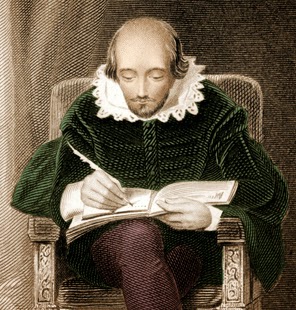Establishing Himself
By 1597, 15 of the 37 plays written by William Shakespeare were published. Civil records show that at this time he purchased the second largest house in Stratford, called New House, for his family. It was a four-day ride by horse from Stratford to London, so it is believed that Shakespeare spent most of his time in the city writing and acting and came home once a year during the 40-day Lenten period, when the theaters were closed.By 1599, William Shakespeare and his business partners built their own theater on the south bank of the Thames River, which they called the Globe. In 1605, Shakespeare purchased leases of real estate near Stratford for 440 pounds, which doubled in value and earned him 60 pounds a year. This made him an entrepreneur as well as an artist, and scholars believe these investments gave him the time to write his plays uninterrupted.
Writing Style
William Shakespeare's early plays were written in the conventional style of the day, with elaborate metaphors and rhetorical phrases that didn't always align naturally with the story's plot or characters. However, Shakespeare was very innovative, adapting the traditional style to his own purposes and creating a freer flow of words. With only small degrees of variation, Shakespeare primarily used a metrical pattern consisting of lines of unrhymed iambic pentameter, or blank verse, to compose his plays. At the same time, there are passages in all the plays that deviate from this and use forms of poetry or simple prose.Early Works: Histories and Comedies
With the exception of Romeo and Juliet, William Shakespeare's first plays were mostly histories written in the early 1590s. Richard II, Henry VI (parts 1, 2 and 3) and Henry V dramatize the destructive results of weak or corrupt rulers, and have been interpreted by drama historians as Shakespeare's way of justifying the origins of the Tudor Dynasty.Shakespeare also wrote several comedies during his early period: the witty romance A Midsummer Night's Dream, the romantic Merchant of Venice, the wit and wordplay of Much Ado About Nothing, the charming As You Like It and Twelfth Night. Other plays, possibly written before 1600, include Titus Andronicus, The Comedy of Errors, The Taming of the Shrew and The Two Gentlemen of Verona.
Later Works: Tragedies and Tragicomedies
It was in William Shakespeare's later period, after 1600, that he wrote the tragedies Hamlet, King Lear, Othello and Macbeth. In these, Shakespeare's characters present vivid impressions of human temperament that are timeless and universal. Possibly the best known of these plays is Hamlet, which explores betrayal, retribution, incest and moral failure. These moral failures often drive the twists and turns of Shakespeare's plots, destroying the hero and those he loves.In William Shakespeare's final period, he wrote several tragicomedies. Among these are Cymbeline, The Winter's Tale and The Tempest. Though graver in tone than the comedies, they are not the dark tragedies of King Lear or Macbeth because they end with reconciliation and forgiveness.
Death
Tradition has it that William Shakespeare died on his birthday, April 23, 1616, though many scholars believe this is a myth. Church records show he was interred at Trinity Church on April 5, 1616.In his will, he left the bulk of his possessions to his eldest daughter, Susanna. Though entitled to a third of his estate, little seems to have gone to his wife, Anne, whom he bequeathed his "second-best bed." This has drawn speculation that she had fallen out of favor, or that the couple was not close. However, there is very little evidence the two had a difficult marriage. Other scholars note that the term "second-best bed" often refers to the bed belonging to the household's master and mistres—the marital bed—and the "first-best bed" was reserved for guests.




No comments:
Post a Comment